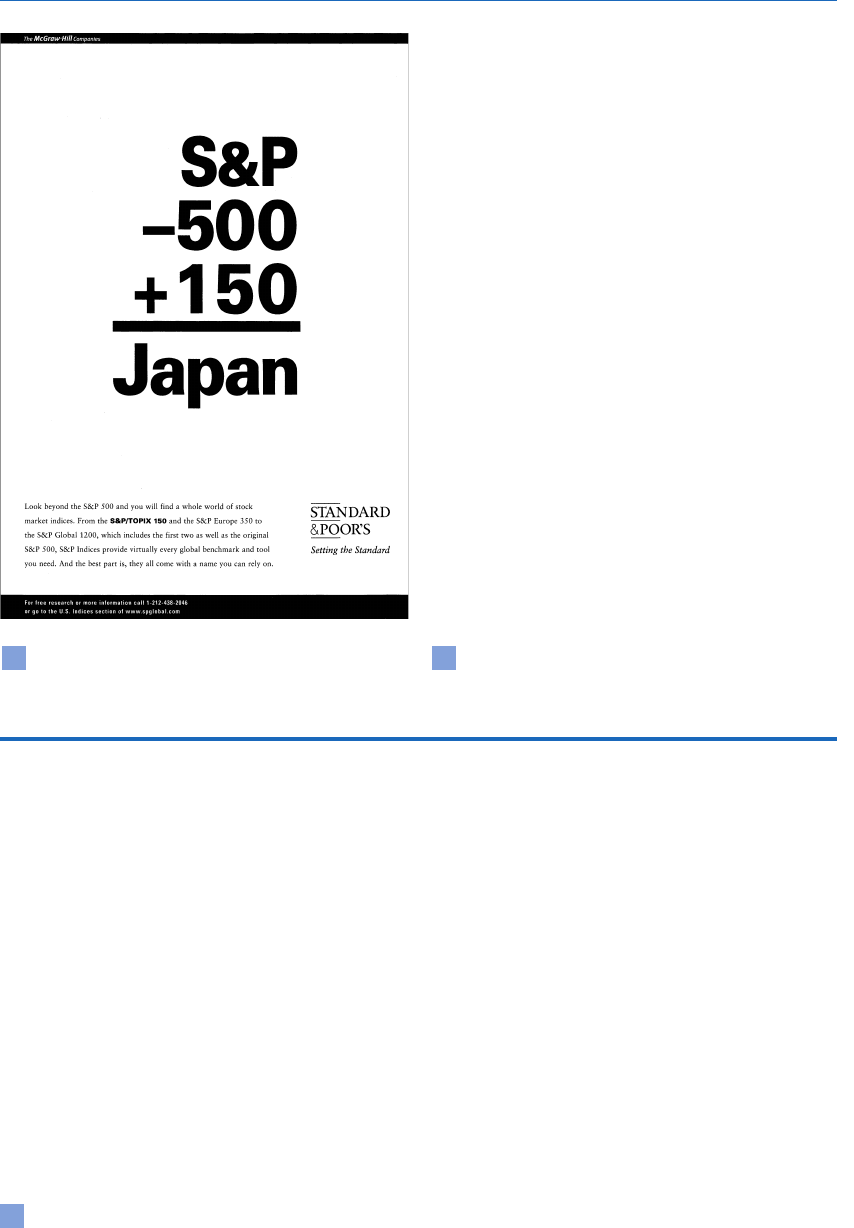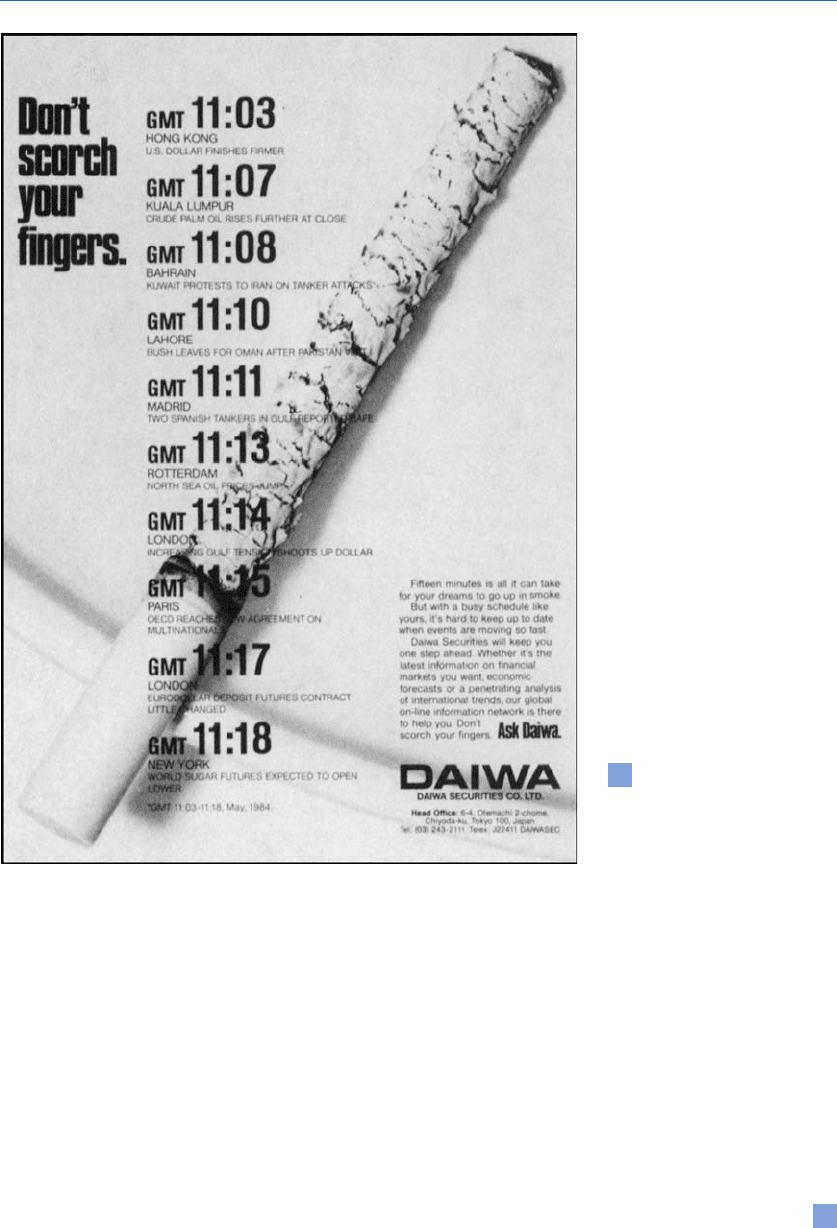Onkvisit S., Shaw J. International Marketing: Analysis and Strategy
Подождите немного. Документ загружается.


DISCUSSION ASSIGNMENTS AND MINICASES
1 The WTO has ruled against the USA three times that a FSC is an illegal subsidy. Should the USA reformu-
late the program to conform to the WTO’s trade rules?
2 Given that foreign competitors through their governments’ assistance are able to offer below-market inter-
est rates or financing, how can US firms fight back to remain competitive?
3 Since New York is the financial center of the world, is there any need for US multinationals to use the
Euromarket and/or the Asian Dollar Market?
4 The Hawley Group has plans to widen its shareholder base: “In addition to common share lists in the U.K.
and Bermuda, and its sponsored American Depository Receipt (ADR) facility in the US, Hawley has recently
obtained share listings in both Australia and New Zealand, imminently expects listing on the international
Division of Montreal Stock Exchange, and is holding active discussion in Frankfurt and Tokyo.” Is there any
need for Hawley to be listed in so many markets?
5 The worldwide demand of many financial products results in the mutual offset link by the Singapore
International Monetary Exchange (SIMEX) to the Chicago Mercantile Exchange (CME), which allows a
contract bought on one exchange to be sold on another. On the Chicago Mercantile Exchange (CME) floor,
the most popular stock index traded is the S&P 500. The interest in overseas stocks explains why the CME
546
SOURCES OF FINANCING
Figure 18.8 S&P Japan Figure 18.9 S&P Europe

holds the exclusive rights outside Japan to create, market, and trade the Nikkei 225 Stock Average futures
contract. The Nikkei Averages are a Japanese stock index based on stocks of all the major publicly held
Japanese corporations. The averages are developed by NKS (Nihon Keizai Shimbun), which publishes the
world’s largest circulation daily business newspaper.The CME has sublicensed its rights for the Nikkei 225
to the SIMEX for trading in the Asian time zone because too few Japanese stocks are traded on US secu-
rity exchanges.
Some believe that, in the future, that which is traded will be the averages based on stock prices of com-
panies worldwide. One development in this direction is Morgan Stanley’s granting the CME a license to trade
futures based on the Morgan Stanley Capital International Europe, Australia, and Far East (EAFE) stock
index. The EAFE index is a diversified portfolio on non-US stocks that cover thirty-eight industries and rep-
resents 63 percent of the total market value of these countries’ stock exchanges. It is considered the perform-
ance benchmark of international market activity.
Do you think that the day may come when US stock indices (e.g., Dow-Jones Industrial Averages, S&P
500) may be overshadowed or even replaced by a world or global stock index that represents the movement
of stock prices worldwide?
NOTES
1 “Foreign Sales Corporations,”
Export America
, December 2000, 32–3; “Trading Volleys,”
Offshore Finance
USA.
(September/October 2001): 12–13; “Taxing Multinationals:The Donnybrook Ahead,”
Business Week
,
September 9, 2002, 86–7.
2 Neil Gregory and Stoyan Tenev, “The Financing of Private Enterprise in China,”
Finance & Development
(March 2001): 14–17.
3 Sattar A. Mansi and David M. Reeb, “Corporate International Activity and Debt Financing,”
Journal of
International Business Studies
33 (first quarter, 2002): 129–47.
4 Andy C.W. Chui, Alison E. Lloyd, and Chuck C.Y. Kwok,“The Determination of Capital Structure: Is National
Culture a Missing Piece to the Puzzle?”
Journal of International Business Studies
33 (first quarter, 2002):
99–127.
5 “Out of the Desert, into the Future,”
Business Week
, August 21, 1995, 78–79.
6 “Modernize This Old-Boy Club? Rubbish!”
Business Week
, January 22, 1996, 39.
7 “NEC Expects to List Shares in the USA,”
Asian Wall Street Journal
, June 26, 2001.
8 Shahrokh M. Saudagaran and Gary C. Biddle, “Foreign Listing Location: A Study of MNCs and Stock
Exchanges in Eight Countries,”
Journal of International Business St
udies 26 (No. 2, 1995): 319–41.
9 Shahrokh M. Saudagaran, “An Empirical Study of Selected Factors Influencing the Decision to List on
Foreign Stock Exchanges,”
Journal of International Business Studies
19 (spring 1988): 101–27.
10 Michael G. Papaioannou and Lawrence K. Duke, “The Internationalization of Emerging Equity Markets,”
Finance & Development
, September 1993, 36–9; “Emerging Stock Markets: What Benefits and Policy
Concerns Are Involved?”
IMF Survey
, June 27, 1994, 201, 203.
11 Ross Levine, “Stock Markets: A Spur to Economic Growth,”
Finance & Development
(March 1996): 7–10.
12 Levine, “Stock Markets,” 7.
13 “Turkish Bourse Falls 18% in Midst of Political Crisis,”
San José Mercury News
, February 22, 2001;
“Turkish Lira Plummets in Economic Crisis,”
San José Mercury News
, February 23, 2001.
14 Christine Pavel and John N. McElravey, “Globalization in the Financial Services Industry,”
Economic
Perspectives
(May/June 1990): 3–18.
1111
2
3
4
5
6
7
8
9
10111
1
2
3
4
5
6
7
8
9
20111
1
2
3
4
5
6
7
8
9
30
1
2
3
4
5
6
7
8
9
40
41
42
43
44
45111
547
SOURCES OF FINANCING

15 Christos Pantzalis, “Does Location Matter? An Empirical Analysis of Geographic Scope and MNC Market
Valuation,”
Journal of International Business Studies
32 (first quarter, 2001): 133–55.
16 Mary Ann Ring, “Innovative Export Financing: Factoring and Forfaiting,”
Business America
, January 11,
1993, 12–14; Elnora Uzzelle, “Forfaiting Should Not Be Overlooked as an Innovative Means of Export
Finance,”
Business America
(February 1995): 20.
17
Trade Bank Services
(BankAmerica Corporation, 1994), 5.
18 “The National Export Strategy,”
Business America
, 1995, 37.
19 “Ask the TIC: Export Financing Programs,”
Export America
(August 2000): 14–15.
20 “US Government Financing for Service Exports,”
Export America
(May 2001): 32–3.
21 Gerd Hausler, “The Globalization of Finance,”
Finance & Development
(March 2002): 10–12.
548
SOURCES OF FINANCING

1111
2
3
4
5
6
7
8
9
10111
1
2
3
4
5
6
7
8
9
20111
1
2
3
4
5
6
7
8
9
30
1
2
3
4
5
6
7
8
9
40
41
42
43
44
45111
549
I don’t distinguish between national and foreign capital. There is no flag on capital.
President Carlos Menem, Argentina
CHAPTER OUTLINE
■ Money
■ Foreign exchange
■ Foreign exchange market
■ Foreign exchange rate
Currency equilibrium
Effect of devaluation
■ Exchange rate systems
Gold standard
Par value (adjustable peg)
Crawling peg (sliding or gliding parity)
Wide band
Floating (flexible) system
■ Official classification of exchange rate regimes
■ Evaluation of floating rates
■ Financial implications and strategies
Early warning systems
Hedging
Leading and lagging
Invoicing
Pass-through costs
Other strategies
■ Conclusion
■ Case 19.1 Ups and downs: a foreign exchange simulation game
Currencies and foreign
exchange
Chapter 19

550
CURRENCIES AND FOREIGN EXCHANGE
PURPOSE OF CHAPTER
George Soros and his Quantum Group serve as an introduction to the value of money as well as the impact
of foreign exchange. It is clear that even a highly regarded professional trader could be wrong. All currency
traders, international bankers, exporters, and multinational corporations realize that volatility exists in the
international financial markets. For example, foreign exchange fluctuations probably cost Lufthansa AG
200 million marks in 1995. Therefore, for firms with international activities, foreign exchange risk is
inevitable and must be managed to keep it at a minimum.
The purpose of this chapter is to discuss the various issues related to international finance. First, it exam-
ines the meaning of money as a medium of exchange. Second, it examines the role of foreign exchange in
international trade while discussing the functions of foreign exchange markets.Third, it focuses on the effect
of currency devaluation and appreciation. There is also an evaluation of the various systems of foreign
exchange and their implications. Finally, some practical guidelines are offered about hedging options used
to reduce foreign exchange risk.
George Soros is perhaps the world’s most powerful
and successful investor. To communicate his views he
uses articles in newspapers, statements to wire ser-
vices, and letters to the editor. His actions and words
have rocked the world financial markets and angered
the countries’ central banks. He played a major role
in derailing the European currency system. When
central banks were on the opposing side of Soros’
trades, they often lost.
He went against the British pound in 1992 and
won. In 1993, he made an announcement on German
TV that he was selling the German mark while buying
US dollars. According to his letter to
The Times
of
London, the Bundesbank had kept interest rates high
for too long and had to reduce short-term rates
sharply. The mark did indeed decline, while the US
dollar climbed. His opinions, being so respected, have
become self-fulfilling in several instances.
He shorted the Thai baht in early 1997, forcing the
economies of Thailand and several other countries to
collapse, so when it was time for Soros to attend
Thailand in 2001 to promote his new book, the Thai
people certainly did not forget. Some promised to
throw eggs and excrement at him.Others wanted to file
criminal charges against Soros for his role in starting
the Asian economic crisis. Thailand’s senior police
officers warned that they could not guarantee his
safety. Logic prevailed, and Soros cancelled his trip.
In defense of Soros, the collapses of the Asian
currencies and economies could not have happened
without the systems’ flawed fundamentals. It was the
Bank of Thailand that chose to gamble tens of billions
of dollars to defend its indefensible exchange rate
system. It was the Thai government leaders who fun-
neled billions of baht into various pockets and who
spent lavishly on mega-projects without addressing
the social, educational, and health needs. Soros cer-
tainly did not urge Thai banks to lend recklessly to
those who speculated on real estate or stocks.
From time to time, even George Soros could be
wrong. In 1994, he believed that Japan would lower
interest rates and that the Japanese yen would fall
in value against the US dollar. However, trade talks
between Japan and the USA broke down. When
markets reopened, traders concluded that the USA
would try to push up the yen in order to narrow the
US trade deficit. The yen surged by nearly 5 percent.
As a result, the $12 billion of assets held by Soros’s
Quantum Group lost nearly 5 percent. He suffered a
loss of $600 million in a single day on February 14,
1994.
Sources:
“The Man Who Moves Markets,”
Business Week
,
August 23, 1993, 50ff.; “A $600 Million Valentine’s Day
Massacre,”
San José Mercury News
, February 26, 1994;
“Editorial: Soros Alone Cannot Be Blamed for Crisis,”
Bangkok Post
, February 1, 2001.
MARKETING ILLUSTRATION THE MAN WHO COULD MOVE MARKETS

MONEY
Money is so simple that most users take it for
granted. Actually, it is one of the great innovations
in history.
1
Being so simple, useful, and common,
money facilitates the exchange of goods and ser-
vices. In the USA, numerous currencies circulated
during the late 1700s and throughout most of the
1800s. It took nearly 140 years after becoming
one nation for the USA to have a successful central
bank in 1914.
2
A hard currency is hard because of the solid
trust that people have in the currency and not
because of its gold backing. Businesspeople must
have faith that the country issuing the currency will
fulfill its obligations. For money to function as a
store of value, there must exist something of value
to store. Even though Russia has gold and oil,people
still have doubts about the ruble as a store of value.
An Act of Parliament does not make a currency
hard or international. Currencies become interna-
tionalized only because they meet the needs of
official institutions and private parties more effec-
tively than do other financial assets. According to
the Federal Reserve Board, nearly two-thirds of the
$300 billion of US currency in circulation is outside
1111
2
3
4
5
6
7
8
9
10111
1
2
3
4
5
6
7
8
9
20111
1
2
3
4
5
6
7
8
9
30
1
2
3
4
5
6
7
8
9
40
41
42
43
44
45111
551
CURRENCIES AND FOREIGN EXCHANGE
There is no love lost between the billionaire hedge
fund financier George Soros and Malaysian Prime
Minister Mahathir Mohammed. Soros sees nothing
wrong with shorting certain currencies while offering
advice to treasury officials around the world about
how to avert financial disasters. Among his victims
are the British pound, German mark, and Thai baht.
In 1997, it started with the devaluation of the Thai
baht that instantly spread to many other countries in
Asia. The Malaysian ringgit was not spared.
Mahathir declared that all currency trading should
be illegal. He was certainly upset with Soros, calling
him “a moron” who set Malaysia back twenty years.
Soros countered by saying that Mahathir’s pro-
posal was a “recipe for disaster.” He added that
Mahathir was “a loose cannon” who was “a menace
to his own country.” Explained Soros: “Markets
cannot be left to correct their own mistakes because
they are liable to overreact and to behave in an indis-
criminate fashion.”
Source:
“Asia Official, Financier Face Off over Free Trade,”
San José Mercury News
, September 22, 1997.
MARKETING ETHICS 19.1 A LOOSE CANNON VS. A MORON
Due to the existence of credit cards,debit cards, online
banking, and so on, it is reasonable to expect paper
and metal currency to have already become obsolete.
But that is not the case in the USA where the cur-
rency per capita (held by the public) exceeds $620
billion, basically $2200 for every man, woman, and
child. Per capita holdings of currency in Europe are
lower but still significant, exceeding $1000 in most
countries, with Germans and Austrians having over
$1800 per person. Japan, however, leads them all with
more than $4000 for every living person.
One advantage of cash over electronic money is
that it promises anonymity to the holder. For crimi-
nals and money launderers, cash is a currency of
choice.In fact, the euro, because of its 500 euro notes,
should be more popular than the US dollar whose
largest notes are $100 bills. However, if cash facili-
tates illegal activities and tax evasion, should govern-
ments then not try to outlaw paper money?
Source:
Kenneth S. Rogoff, “The Surprising Popularity of
Paper Currency,”
Finance & Development
(March 2002):
56–7.
CULTURAL DIMENSION 19.1 PAPER MONEY

of the USA. Ex-communist economies and South
America’s inflation-wracked countries demand US
dollars in their attempt to seek economic stability.
Panama and Liberia have long used the US dollar as
their official currencies. Honduras, Hong Kong, and
several Asian countries have pegged their money to
the dollar. While it is true that the US dollar now
comprises only half of official foreign exchange
reserves, the dollar is still the world’s most instantly
and easily recognized international currency. Due
to historical reasons, the former Soviet economies
were hesitant to accept the German mark. Japan, on
the other hand, is reluctant to allow the yen to
become an international transaction currency.
An international currency fulfills three basic
functions in the global monetary system: it serves
as a medium of exchange, a unit of account, and a
store of value. As a medium of exchange,private
parties use an international currency in foreign
trade and international capital transactions, whereas
official agents use it for balance-of-payments financ-
ing and to intervene in foreign exchange markets.
As a unit of account, private parties use an inter-
national currency for invoicing merchandise trade
and for denominating financial transactions,
whereas official agents use it to define exchange rate
parities. As a store of value, international currencies
are held by private agents as financial assets (e.g., in
the form of bonds held by nonresidents) and by offi-
cial agents (such as central banks) as reserve assets.
For a currency to be used internationally, two
sets of factors are essential. First, there must be con-
fidence in the value of the currency and in the polit-
ical stability of the issuing country. Second, a
country should possess financial markets that are
substantially free of controls.These markets should
be broad (i.e., contain a large assortment of finan-
cial instruments) and deep (i.e., have well-devel-
oped secondary markets). The country should also
possess financial institutions that are sophisticated
and competitive in overseas financial centers.
FOREIGN EXCHANGE
Foreign exchange transactions involve the purchase
or sale of one national currency against another.The
easiest way to understand this type of transaction is
to view money as just another product that cus-
tomers are willing to buy and sell. Like other prod-
ucts, money can be branded, and the US dollar,
Swiss franc, Japanese yen,and so on are simply some
of the brand names for a money “product.” Some of
these brand names carry more prestige and are
more desirable than others, much like brand names
of consumer products.
People often wonder why it is necessary to have
so many different currencies (see It’s the Law 19.1).
Obviously, it would be preferable to have only one
worldwide currency that could be used anywhere
on Earth, similar to the US dollar’s being used and
accepted in all fifty states. But a global currency is
currently impossible due to two uncontrollable
factors – national sovereignty and inflation.
Under normal circumstances, it is very rare for
a country to adopt another country’s currency as its
own. One exception is Liechtenstein, which signed
a customs treaty with Switzerland in 1923, making
the Swiss franc its official currency. Moreover,
Liechtenstein’s customs affairs are administered by
Switzerland.
Many Americans, knowing that the dollar is
widely accepted, do not understand why the US
dollar cannot become a global currency and why
other nations resist replacing their national curren-
cies with the US dollar.The resistance may perhaps
be better understood if one imagines the tables
being turned.Would the American public be willing
to abandon the dollar and replace it with a new
global currency? The fact that the USA is so unwill-
ing to embrace the metric system in spite of its
demonstrated superiority underscores this point
clearly. Because of national pride, no nation wants to
give up its identity and sovereignty, and this includes
its national currency. National pride may also
explain Great Britain’s reluctance to allow the
pound to join the European Monetary System
(EMS), especially since the British believe that the
pound has a more important role in the inter-
national financial world. Great Britain withdrew the
pound from the EMS in 1992 and has so far refused
to switch to the euro.
552
CURRENCIES AND FOREIGN EXCHANGE

A less emotional but often uncontrollable issue
is inflation, which reduces the value of money (i.e.,
purchasing power). Since it is impossible for all
nations to have an identical inflation rate, the effect
of inflation on the value of various currencies is
uneven. In Argentina, the inflation rate was greater
than 400 percent in 1984, and it subsequently accel-
erated to more than 800 percent, forcing the gov-
ernment to adopt the austral as its new currency in
1985. Inflation in the USA at the same time was
running in single digits. In China during the 1940s,
the currency had so little value that the Chinese had
to cart their money around in wheelbarrows. After
World War I, the value of the German mark stood
at 4 trillion marks to a dollar.
These examples should make clear that it is
impractical for any single currency to be used on a
worldwide basis while maintaining constant value in
all countries.
FOREIGN EXCHANGE MARKET
Firms needing to make payment for foreign business
transactions never seem to have enough currency on
hand, and it is cumbersome for them to seek out
those with adequate amounts to sell.There is thus a
need for a foreign exchange market to suit all indi-
viduals and institutions in order that they may
contact one another for this purpose. The foreign
exchange market as it exists has no central trading
floor where buyers and sellers meet. Most trades are
completed by banks and foreign exchange dealers
using telephones, cables, and mail. As a worldwide
market, the foreign exchange market operates
twenty-four hours a day.
The foreign exchange market facilitates financial
transactions in three different ways. First, it pro-
vides credit or financing for firms engaged in inter-
national business. This can be achieved through a
variety of means, such as letter of credit, time draft,
forward contract, and so on. Second, it performs
a clearing function similar to a domestic bank’s
clearing process for checking-account customers.
Clearing is a process by which a financial transac-
tion between two parties involving intermediation
between banks is “settled.” In the case of inter-
national clearing, the funds are transferred on paper
from a commercial customer to its local bank, from
1111
2
3
4
5
6
7
8
9
10111
1
2
3
4
5
6
7
8
9
20111
1
2
3
4
5
6
7
8
9
30
1
2
3
4
5
6
7
8
9
40
41
42
43
44
45111
553
CURRENCIES AND FOREIGN EXCHANGE
Match the country with the currency:
Elementary level
1 France A dollar
2 Hong Kong B euro
3 Japan C dollar
4 United Kingdom D pound
5USA E yen
Intermediate level
1 Australia A dollar
2 Mexico B won
3 Russia C peso
4 South Africa D rand
5 South Korea E ruble
Advanced level
1 Bangladesh A tugrik
2 Burma B pataca
3 Cambodia C riel
4 Macau D kyat
5 Mongolia E taka
IT’S THE LAW 19.1 CURRENCY QUOTIENT

there to a New York bank, and finally to a foreign
bank abroad. The process allows payments to be
made for foreign goods without a physical transfer
or movement of money across countries.
Third, the market furnishes facilities for hedging
so that businesses can cover or reduce their foreign
exchange risks. Hedging is an activity that is used
as a temporary substitute purchase or sale for the
actual currency. This temporary transaction allows
users to protect the price they secure from fluctua-
tions because it establishes equal and opposite posi-
tions in the market.
The rationale for hedging lies in the exchange
rate fluctuation, which can move significantly and
erratically, even within a short time. For example,
due to inflation and instability, the Russian ruble lost
27 percent of its value against the US dollar in a
single day in 1994. The panic started when the
central bank stopped supporting the declining
ruble. The ruble tumbled from 3081 to the dollar
to 3926, and it was a record fall. In just three
months, the ruble lost half its value. Consumers, to
hedge against price increases, bought merchandise
as much as they could, while merchants sharply
marked up prices.
Figure 19.1 provides a good illustration of the
high degree of volatility in the foreign exchange
market. Since it is common for a customer to take
some time in accepting the quoted price, placing an
order, and making payments,financial loss caused by
exchange rate movement can easily occur.Without
a hedge, an American exporter selling to an Italian
customer will suffer financially when the euro
declines in value (or the dollar increases in value)
because the euros paid, after conversion, will yield
fewer dollars than first expected.
Some observers may conclude that, though the
danger of the falling euro to the US exporter is real
and serious, there is an equal opportunity for the
euro to gain in value instead. Under this scenario,
the exporter can increase the expected profit –
once from the sale of the goods and again from
the exchange gain. Based on this contention, the
exporter would miss the windfall profit if the
exporter had hedged. The problem with this idea,
however, is that the exporter is in reality a mere
amateur as far as the speculation game is concerned.
He or she may be an expert in and have wide know-
ledge of the manufacturing and selling of products.
However, the exporter is not in the business of
making windfall profits and should concentrate on
familiar trading operations rather than attempting
to be a gambler in the unfamiliar and risky game of
currency speculation. The caution applies to the
Italian importer as well, especially when payment is
to be made in dollars instead of euro. As demon-
strated by Shell Sekiyu, a Japanese-Dutch oil refiner
and distributor, its finance department lost more
than $1 billion by making a bad bet in the futures
market that the dollar would rise in 1993.
The foreign exchange market provides a hedging
mechanism needed to protect corporate profits
against undesirable changes in the exchange rate
that may occur in the future. For this purpose, the
market has two submarkets – spot and forward.The
two differ with respect to the time of currency
delivery.The spot market is a cash market where
foreign exchange is available for immediate delivery.
In practice, delivery of major currencies occurs
within one or two business days of the transaction,
whereas other currencies may take slightly longer.
A US firm holding foreign currency can go to its
bank for immediate conversion into dollars based on
the spot rate for that day.
Exporters should also consider doing some
hedging well before the arrival of foreign funds, and
this is where the forward market becomes sig-
nificant. Companies can protect themselves by
selling their expected foreign exchange forward. A
forward contract is a commitment to buy or sell
currencies at some specified time in the future at a
specified rate. By signing a forward contract of, say,
forty-five days, a company has locked in a certain
rate of exchange and knows precisely how many
dollars, after conversion, it will get – even though
payment, conversion, and delivery will not be made
until later (i.e., forty-five days after).
It should be understood that the exchange rate
specified in the forty-five-day forward contract is
not necessarily the same rate as the forward rate of
554
CURRENCIES AND FOREIGN EXCHANGE

the next day or the spot rate of forty-five days later.
Both rates change constantly, fluctuating from day
to day and even from minute to minute. The only
rate that will stay unchanged is the one agreed on
by the bank and the hedger as stipulated in the
signed forward contract, even though subsequent
forward and spot rates may move drastically the day
after the signing of that contract.
An exporter should realize that, in most cases,
the spot rate is irrelevant for the preparation of
price quotations and the determination of opera-
tional costs, since foreign currency as payment is
not received until a later date. Since there is no
immediate conversion, the forward rate is the more
appropriate one.The expectation in terms of inter-
est rate inflation has already been factored into the
agreed-on forward rate.
It is not uncommon for companies to limit their
exposure to foreign currency fluctuations by requir-
ing payments in US dollars or other currencies
1111
2
3
4
5
6
7
8
9
10111
1
2
3
4
5
6
7
8
9
20111
1
2
3
4
5
6
7
8
9
30
1
2
3
4
5
6
7
8
9
40
41
42
43
44
45111
555
CURRENCIES AND FOREIGN EXCHANGE
Figure 19.1 Volatility of
the foreign exchange rate
Source:
Reprinted with permission
of Daiwa Securities Company
Limited.
